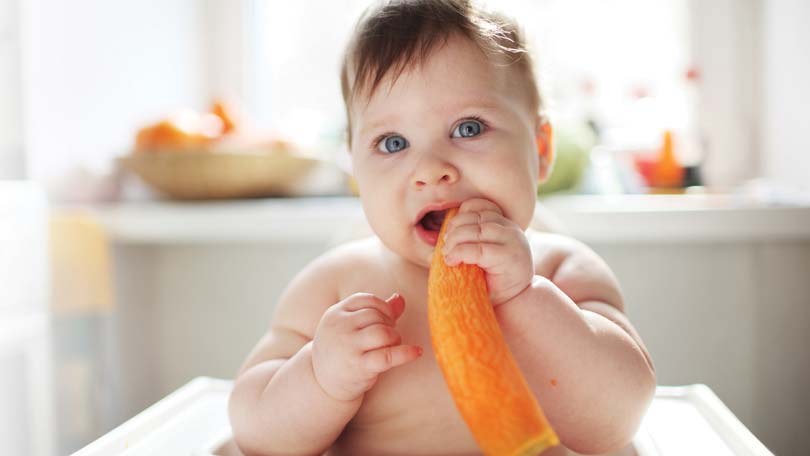
One of the challenges to raising children occurs when they are toddlers. This is the transitional stage when they are weaning from breast milk, or formula, to more solid foods. Children at this stage can become very fussy, and it is sometimes a chore to get them to eat the right foods.
One way to encourage them to eat is with finger foods. At this stage, children are curious, and love to explore things with their hands, and mouths. Finger foods satisfy all three needs. Another advantage to finger foods is that they allow the child to learn to feed him, or herself, and gives them a certain sense of independence. Finger foods are also portable. They can be prepared ahead of time, and taken along when you have to leave the house. If your child becomes restless, you can calm him or her down with a tasty treat.
Before you can select the right finger foods for your child, you need to know a little about the nutritional requirements for children of this age. Toddlers require 1400 calories daily. If they are very active, they may need even more. The caloric intake must have the right balance of nutrients as well. The USDA recommends the following:
- Proteins should make up 5% to 20% of the daily diet.
- Carbohydrates should account for 45% to 65%.
- Fat should make up 30% to 40%.
- A toddler needs 1000 mg of sodium, 19 g of fiber, and 500 mg of calcium daily.
- Do not feed cows’ milk, honey, eggs, or citrus fruits, or juices to children under age 1, and no peanuts or seafood to children until after age 2.
Another consideration is not to put anything in finger foods that may cause the child to choke, such as crunchy peanut butter, whole grapes, whole raisins, potato chips, popcorn, nuts, or anything they might swallow without chewing. It is still easy to come up with finger foods your child will enjoy, as long as we keep all this in mind. Finger foods should be large enough to have to be chewed, but small enough for the child to easily manage. The nice thing about finger food is that you don’t have to be a professional chef to be able to prepare them. They are easy and quick.
One of the easiest finger foods to give your child is grains. Cheerios, Corn Pops, Honeycomb, Captain Crunch, Chex, Life, and similar cereals are all good choices. Avoid cereals with nuts and small hard pieces in them like granola, muesli, and Lucky Charms.
Fruits make very good finger foods for toddlers. Cut them in small strips or pieces (making sure there are no seeds), and arrange them in flower shapes on the plate. For an added treat, you could place a small dollop of yogurt in the middle for them to dip the pieces in. Apples, melons, pears, bananas, halved grapes, mangos, pineapple, strawberries, and similar fruits are very good choices. Avoid citrus fruits due to the seeds.
You can even cheat a little if they get extra fussy. If you can’t tempt your child with plain fruit, try my old trick. Cut bananas, peaches, avocado, and or tofu in to 1″ cubes and roll them in crushed Cheerios, graham crackers, or wheat germ. Coat them completely and let your child chow down. These things are almost irresistible, even for adults.
Here is another trick. Kids of all ages love quesadillas. Just leave off the hot peppers, and use fully cooked chicken, or refried beans. Onions will depend on your child’s taste. Some children like onions, some don’t. You can also use fully cooked ground beef, but don’t make it too spicy. Cut the quesadilla into pizza wedges. You can also wrap lunchmeat, tomatoes, peanut butter and jelly, cream cheese, and other foods in flour tortillas, then cut it into small sections that they can handle easily.
And, here is the ultimate fool-proof toddler food. Kids love grilled cheese sandwiches. Cut the sandwich into quarters and watch how they attack them.
An exception to the seafood rule is fish sticks. These are a sure-fire way to tease a toddler’s appetite. Put a dollop of catsup (another can’t fail kid-pleaser) or tarter sauce on the plate for them to dip into, and watch them disappear. Another great finger food is Tater Tots. Actually, anything they can eat with catsup will work. Other good choices are French fries, and sweet potato fries. And don’t forget chicken nuggets.
Here is a recipe that I have used on my children, grandchildren, and hopefully, great-grandchildren. It has never failed me, yet.
Sweet Potato Fries
1 qt water
1 large sweet potato, peeled, and cut into French fries
1/2 tsp. salt
1-1/2 cup crushed Cheerios
1 egg, beaten
Oil for deep frying
In a medium pot, dissolve the salt in the water and heat to boiling over med-hi heat.
Boil the potato strips in the salted water until they are tender. Discard the water.
While the potatoes are boiling, beat the egg in one bowl, and put the crushed Cheerios in another.
When the potatoes are done, place them, on paper towels to dry for a few minutes. Then, roll each one in the Cheerios, the dip in the egg wash, and roll once again in the Cheerios. Place on a flat sheet until they are all done.
Heat the oil to frying temperature in a deep fryer, or skillet. Fry the potatoes until they are golden brown. Drain them on paper towels, and allow cooling somewhat before serving.
Don’t forget the old stand-bys like Vienna Sausages, and sandwich strips made from potted meat, deviled ham, cream cheese, pimento cheese, lunch meats, tuna and chicken salad (no nuts).
With a little planning, it is easy to prepare finger foods for toddlers.





